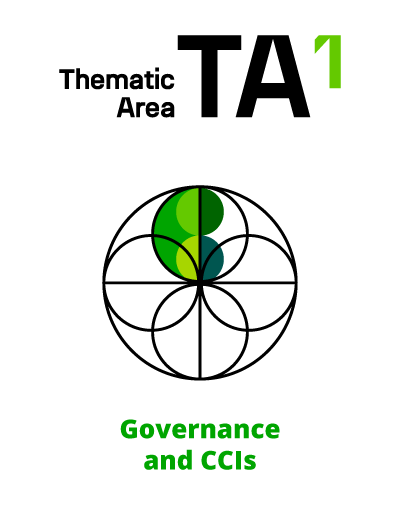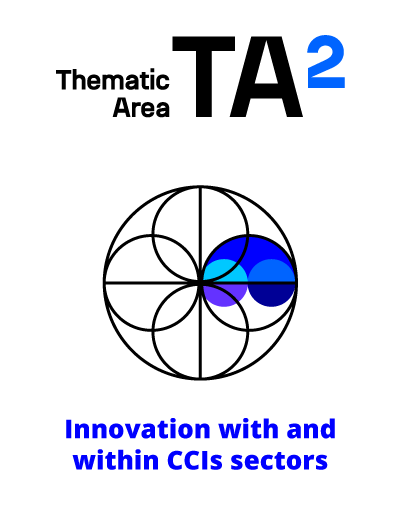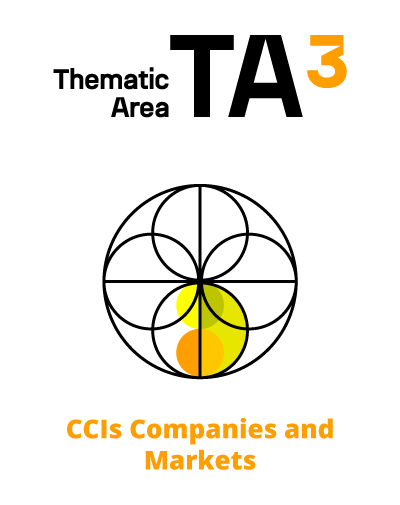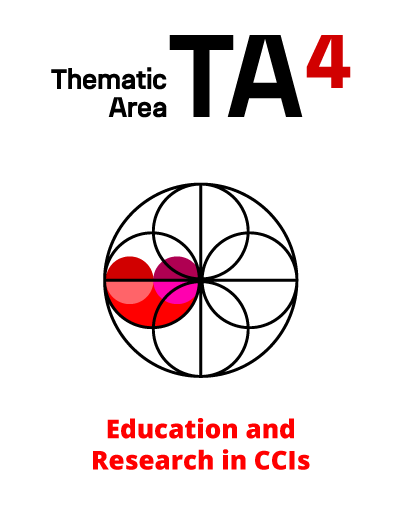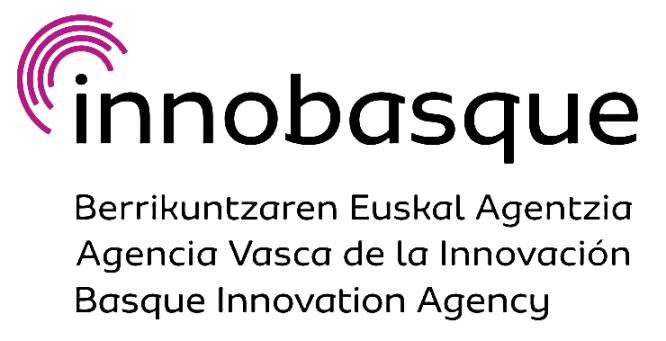Governance and CCIs
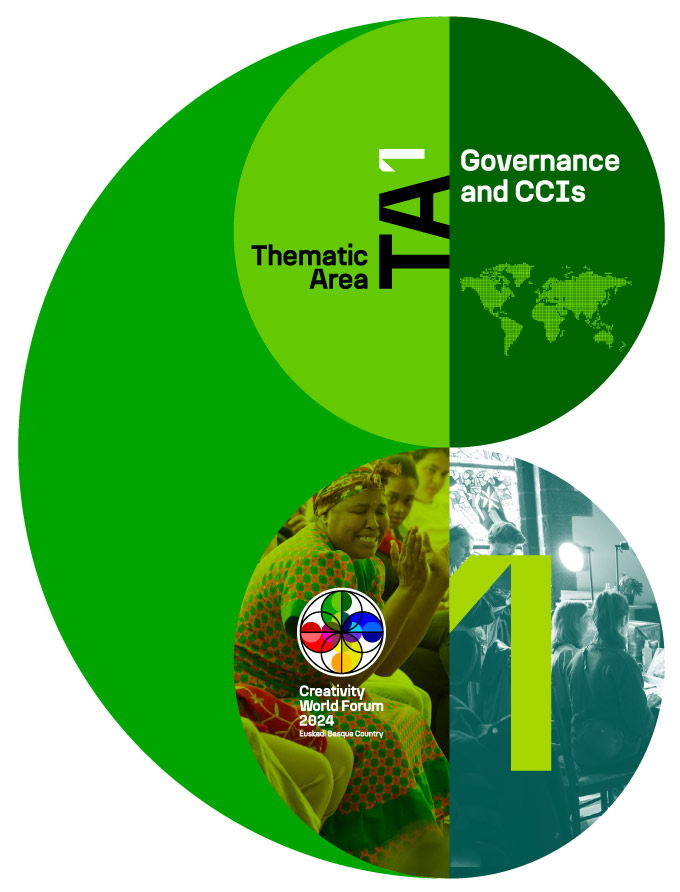
Development of more efficient and innovative CCIs governance models and policies, from an holistic and cross-innovation point of view while tackling economic sustainable development
Coordinating entity
Challenges

Challenge 1
Models of innovation in CCIs governance policies at an international level

Challenge 2
CCIs policy evaluation systems
The final selected cases for CWF 2024 within TA1 Governance and CCIs
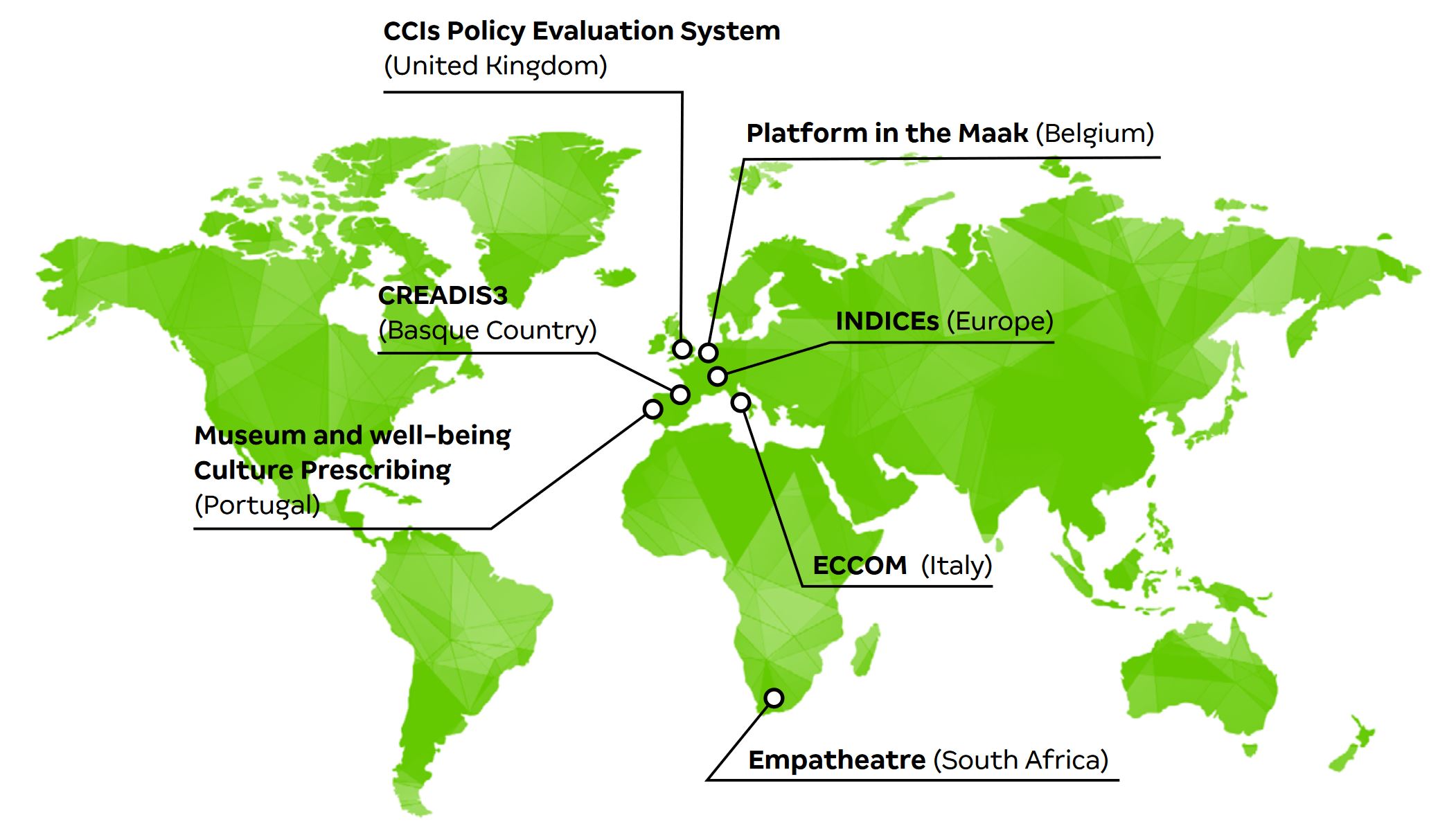
Museum and well-being culture prescribing

Challenge 1
Models of innovation in CCIs governance policies at an international level
From

Contact person
Raquel Barata
The birth
Museums have the power to create the link between heritage and wellbeing facing current societal challenges. In the last decade, the social role of museums has been highlighted for therapeutic purposes, that is, the possibility of occupying users with tasks in museums, by medical indication. Museums and botanic gardens may, therefore, promote opportunities for social interaction and relaxing experiences to promote self-esteem and identity and reduce the levels of isolation and anxiety. This new approach has been called cultural prescribing: the National Museum of Natural History and Science (Portugal) started a network in Lisbon in order to implement prescribing initiatives using the museum and botanic garden collections.
The journey
The National Museum of Natural History and Science of the University of Lisbon is developing the Museums and Wellbeing – cultural prescribing project, in partnership with national entities aiming to prepare Portuguese museums and botanic gardens for cultural prescribing. This project targets university students promoting the inclusion and attraction of young adults, but also includes cultural prescribing interventions for users of the local health units and for senior groups of day care centres of neighboring communities.
For museums, the challenge to embrace cultural prescribing is to integrate into their staff people who can develop the interventions together with the doctors and psychologists who prescribe them as therapy. This task has been allocated to the educational services of museums, as they include professionals with experience and skills for the work with different audiences. However, training and specialization is necessary and urgent.
The positive impact
The impact of the project is indicated by a qualitative approach among the participants. Since March 2022 until May 2023 the project included 5 university students, diagnosed with burnout and anxiety, 4 clinical patients from the health centres diagnosed with depression and anxiety and 22 senior people from day care centres with the profile of social isolation and depression.
The results of the interviews done with such participants indicate wellbeing promotion of cultural prescribing initiatives by allowing stress reduction, competence and enjoyment among the University students, as well as promoting self-confidence, competence and social involvement among clinical patients and helping social involvement, enjoyment and place attachment among the senior people.
The growth and collaboration
The Museums and Wellbeing project foresees the broad involvement of the national and international academic community in the research about this topic, including the development of impact assessment. A training course is also to be offered in 2024 by MUHNAC-ULisboa and the Museums of the University of Edinburgh on cultural prescribing at museums and botanic gardens. It is intended that other health units, universities and museums join this network to promote cultural prescribing at a national level, as well as to collaborate at an international level with other similar projects.
Platform in the Maak

Challenge 1
Models of innovation in CCIs governance policies at an international level
From

Contact person
Eline Dewaele
The birth
Platform In De Maak was founded in 2019 by Barbara T’Jonck, Eline Dewaele, Oihana Azpillaga and Zoë Demoustier as a presentation platform for starting makers in the performing arts. Feeling discouraged by gatekeepers and disconnected from their own generation, they decided to create their own context for performing work without artistic selection.
The journey
After the first festival in 2019, the core group of Platform In De Maak wanted to continue working together and creating opportunities for starting makers. Based upon their experiences and reflection, they (re-)created an organisational structure based on the principle “who organizes, rograms.” Since 2019, four more festivals have been organised, always growing in scope and audience
The positive impact
The platform was founded in 2019 with multiple missions in mind. During the last 4 years, it has been able to have an impact within each mission. Highlights are:
• Four different festival editions in 2019, 2021 and 2022 with a growing audience.
• 76 different makers have been able to work together and/or present.
• From a platform for presentation to a platform for development and presentation.
• Being a voice in conversations about artist-run, horizontal ways of organizing: i.e. Kunstenpunt, STUK and Habitat Festival.
The growth and collaboration
Platform In De Maak has outgrown its city fundings and has applied in September 2023 for a project subsidy from the Flemish Government. This subsidy is necessary to continue the mission. Platform In De Maak has created an 18-month development trajectory (from Sep 2023-Mar 2025) for 20 starting makers*, in which the makers have both the possibility to develop artistically as well as learn other organizational skills. The trajectory ends with a performing arts festival in Leuven. For this new trajectory, Platform In De Maak has grown its partners and scope throughout Flanders and Brussels.
*a starting maker is a performer or lighting technician, a choreographer or cultural worker, a dramaturg or scenographer, a graphic designer with an affinity for the performing arts, an aspiring business manager or costume designer, etc.
Empatheatre

Challenge 1
Models of innovation in CCIs governance policies at an international level
From

Contact person
Dr. Dylan McGarry
The birth
In a world rife with societal inequalities, Empatheatre stands as a sanctuary and refuge during complex and ncertain times, offering innovative and creative approaches to address pressing issues. Founded in 2014, Empatheatre believes that, in unequal societies, where popular and political debates are often polarized and marginalized voices are ignored, it is crucial to explore different ways of knowing, being, and doing. The organization has championed creative and empathetic methods to facilitate multiple forms of listening, fostering knowledge-sharing across diverse publics.
The journey
The organization’s journey has taken it through diverse issues, including land-based mining and displacement, street-level drug addiction, vulnerabilities faced by migrant women, xenophobia, gentrification, public housing conflicts, and even ocean heritage and governance. mpatheatre’s approach is rooted in extensive action-based research. The creative team collaborates with co-participants and key partners to identify matters of critical concern for social justice, honing in on a pressing central question. This process involves listening to multiple narratives, exploring different scales and positionality, and delving into archives and wide-ranging reading. The organization shapes the research findings into an engaging, relevant, and true-to-life theatrical script, which is then shared with participants and partners for feedback. This iterative process ensures that the script remains credible and resonates with the communities it represents. The Empatheatre team then proceeds to devise and rehearse the theatrical production. This production is once again shared with relevant knowledge holders from diverse backgrounds, enriching and verifying the research. After receiving approval from project collaborators, the performances are rolled out to strategic audiences, including policymakers, participants, and concerned publics. The heart of Empatheatre’s approach lies in post-play conversations, which are meticulously facilitated as public dialogues between the audience, actors, and playmakers. These conversations enable yet another layer of research to emerge, as diverse viewpoints and insights are shared.
As such, our impact is more geared to systematic change, through changing processes, policies, practices and even changing the law. We have also once-off-change, in the fact that we create theatre productions, films and other media outputs, which can be seen as products, and go on to have their individual educational impact in society.
The positive impact
Empatheatre’s reach has been extensive, with performances reaching thousands of South Africans and other audiences abroad. These productions have been staged in various venues, from theaters and art galleries to schools, churches, police stations, football fields, aquariums, and rehabilitation centers. We have performed at the IPCCC climate conference in Egypt COP 27, in Nov 2022, we have performed and run processes (and workshops) for the FAO headquarters in Rome, March 2023, and have run workshops and addressed the UN general Assembly in NYC in June 2023. We have had our plays and films used as evidence in Court in South Africa, We have also had many extra-legal impacts by changing policing practices, establishing the first harm reduction program for drug users in Durban, and also have had many other smaller conflict transformation impacts in our projects, with different civil society organizations etc. If you’re interested in joining these efforts, getting involved, donating, or learning more, visit www.empatheatre.com. Empatheatre’s remarkable journey stands as a testament to the power of empathy, creativity, and participatory justice in addressing societal challenges in unequal societies.
The growth and collaboration
Empatheatre has reached international acclaim, and won several awards both for its theatre and for its societal impact, we have toured international, changed policy, created evidence for court and created sanctuaries for conflict transformation in many different social spaces, yet we are still struggling to raise resources and capital for the overheads and running of our Organisation. As such our future goal, is to get CSI investment that would cover our running costs, and for us to establish a permanent team, and move away from ‘project-to-project’ funding, and towards an ongoing partnership with organisations, municipalities, governments, and other partners, where we can build long term relationships to conduct research, create tribunals, develop responsive educational processes, build sanctuaries for public storytelling and decision making, and to further build and expand our research.
ECCOM

Challenge 2
CCIS policy evaluation systems
From
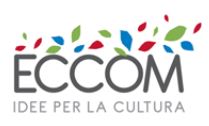
Contact person
Cristina Da Milano
The birth
ECCOM has been founded in 1995 by a group of cultural professionals who aimed to having a multidisciplinary and innovative approach to the cultural sector. As a private organization in a context at the time almost completely in the hands of public institutions, it brought, as added values, new perspectives, ideas, knowledge. Being a project-based organisation, it fostered a managerial approach to culture, at the same time working on issues such as social and cultural inclusion in the perspective of enhancing the value and the potential of the cultural system.
The journey
ECCOM was born as a non-for-profit association; in 2007, a limited company has been created, called ECCOM Progetti s.r.l., to develop services and provide consultancies. Its economic model has been based on the participation to local, national and European public calls, since it has never had and operational support from public bodies: the hardest part of it has been setting up a cv and developing project planning and managing skills, both needed in order to get fundings through calls. Little by little, ECCOM started building its own strong reputation, which initially was based mainly on its individual members’ ones.
The positive impact
Through the years there has been a concrete and constant economic growth of the organisation in terms of yearly turnover, number of staff members, number of external collaborators, number of projects managed. ECCOM’s social and cultural impact has increased in terms – for example – of transformation and deep change of many of the cultural professionals who took part in our programmes/activities, of students we have worked with, of communities which normally do not have access to culture. All this, through new narratives and a plurality of points of view, participated storytelling aiming at creating new visions, meanings, intercultural approaches. ECCOM’s attention is also devoted to foster an integrated vision of the sector in which environmental issues occupy a crucial place: natural and cultural heritage should be seen as a unique, integrated system of relationships.
The growth and collaboration
ECCOM has developed a network of local, national and international relationships with different kinds of organisations and institutions, giving birth to stable and long-lasting partnerships in different sectors (from heritage – both tangible and intangible – to cultural policies, from education to social stakeholders). ECCOM’s member have been active in different activities and interventions addressed to urban, cultural and social regeneration through co-creative planning with local communities, with a specific focus on new generations and artists as trigger of new processes and new contemporary creations able to create a bridge between the past, the present and the future.
Creative Industries Policy and Evidence Center

Challenge 2
CCIS policy evaluation systems
From

Contact person
Professor Hasan Bakhshi MBE
The birth
The Creative PEC was founded in 2018 and funded by the Arts and Humanities Research Council (AHRC) as part of the UK government’s commitment to the creative industries in its 2017 Industrial Strategy. It was charged with providing a step change in the quantity and quality of independent evidence to inform the development of policies to support the UK’s creative industries. Through its strong links with industry, such as its network of Industry Champions, and its researchers’ embeddedness with policymakers, the Creative PEC’s research programme has been seen as highly responsive to the policy needs of industry and policymakers. As a consequence of this responsiveness, the Creative PEC secured another 5 years of funding from the AHRC from June 2023.
The journey
In its first incarnation, the Creative PEC was structured as a large consortium of researchers drawn from ten universities and the innovation foundation, Nesta, each of whom were on fractional appointments, committing, say, a tenth or a fifth of their time to Creative PEC activity. The strength of this arrangement was the Centre’s breadth of expertise. But its weakness was the somewhat fragmented nature of the consortium, which made curation and managing delivery of the Creative PEC’s research more challenging than it need be. To address this structural weakness, in the next phase of the Creative PEC’s work we are working with a much smaller number of consortium partners (four) but are aiming to maintain, indeed grow, the breadth of our expertise through a new global network of research fellows. Although initially funded through the UK’s 2017 Industrial Strategy (which has already been superseded), the Creative PEC’s early successes has meant that it is now funded through the AHRC’s baseline budget: it is viewed as an essential part of the UK’s creative industries research infrastructure.
The positive impact
The Creative PEC’s research in a wide range of policy areas is heavily cited in UK government strategy documents and in parliamentary debates. For example, the government’s flagship Creative Industries Sector Vision, published in June 2023, cites 12 Creative PEC reports in 37 places
The growth and collaboration
In the next phase of the Creative PEC’s work we have introduced a twin-hub structure, whereby in addition to our established base in the South of England (now at the Royal Society of Arts, RSA in London) we are developing a Northern hub at Newcastle University. This will enable us for the first time to deliver our distinctive “embedded” approach to knowledge exchange with policymakers in the North of England. We view this very much as an experiment. If we are successful in our Northern Hub we may develop a triple or quadruple hub structure in future years. The strategic partnership with the RSA is another essential feature of Creative PEC 2.0. We hope to combine the RSA’s strengths in practical programmes with the Creative PEC’s research excellence to explore a “think-do” approach to creative industries development, drawing on the earlier experiences of Nesta in this area.
INDICEs

Challenge 2
CCIS policy evaluation systems
From

Contact person
Maria Tartari
The birth
The European Horizon 2020 project inDICEs seeks to empower CCIs, Institutes, and policymakers by providing a comprehensive understanding of the social implications of digitization, thereby encouraging innovative approaches to the utilization of cultural assets. A key objective is to redirect the focus towards novel criteria for devising strategic plans and measuring participation founded on the impact of active participation on societal challenges. Based on the theoretical framework “3.0 Culture”, we elaborated a theoretical matrix “Change Impact Assessment Framework”, that emphasize the significance of incorporating novel models of collaborative production, co-authorship and contamination into the value-creation processes of cultural activities in the digital, and how this can impact on various areas and layers.
The journey
The inDICEs project was made up of a cross-sectorial consortium of 14 entities (from Humanities, Social Science, Law and IPR, Computational Sciences) and a network of European stakeholders such as CHIs, Policy makers and researchers.
All subjects collaborated horizontally, through agile governance and digital co-creation tools, to bring their expertise to achieve the project objectives by contaminating each others. The co-creation processes between professionals from such different sectors, seemingly incommunicable worlds, has proven to be both challenging and very enriching
The positive impact
The “Change management and policy recommendations”, one of the main outcomes of the project, is a policy framework developed to understanding cultural value chains and impact of cultural heritage, combined with insight from specific cases of re-using digital cultural resources: this tool has been studied from 452 users among policy-makes, cultural professionals and students. The “Change Impact Assessment Framework” tool has been read and shared by 163 users from the CHIs world.
The growth and collaboration
Currently we are building, with a network of partner institutes (such as the Bologna Civic Museums network and others to be confirmed), specific pilot projects to apply and implement measurement according to the strategy suggested in the Change Impact Assessment Framework. They will test the framework, develop specific indicators and share the results with the inDICEs community. Moreover, we are carrying out the scientific dissemination of the results of big-data analyzes applied to cultural participation.
CREADIS3

Challenge 2
CCIS policy evaluation systems
From

Contact person
Josean Urdangarin
The birth
The Smart Specialisation Creative Districts/CREADIS3 project was born with the objective in mind to align erritorial public policy agendas to support the development of more efficient Culture and Creative Industries/CCIs policies, aiming to generate innovation and economic development in 6 European territories (2017-2021). In the case of the Basque Country, the main objective was to implement a common regional and territorial strategy of economic development and R&I initiatives, reinforcing the cooperation and governance among the 3 institutional levels in a “smarter” (under RIS3 values) and efficient way.
The journey
2017 was a strategic year in the development of the RIS3 CCIs Euskadi, since for the first time a comprehensive and agreed strategy for CCIs was proposed, coinciding with the start of this European project CREADIS3. After the first phase of the project (2017-2019), the period 2020-2021 were critical, because the process needed to think less about linear instruments in order to move on thinking about multidimensional models to develop CCI strategies. In our context, within this period 2020-2021, we prioritized 3 dimensions with their respective actions:
• Dimension 1 of cohesion and visibility of the CCIs through innovation: BDCC (Basque District of Culture and Creativity), pilot implementation in 2020-2021.
• Dimension 2 of multilevel governance and cross fertilization: Development of the RIS3 CCI strategic Pilot Group via working groups with specific objectives and projects.
• Dimension 3 of knowledge and conceptual development of the field of Culture and Creativity: Statistical operation of financing and public expenditure on Culture and Creativity in the Basque Country.
The positive impact
CREADIS3 gave us the possibility of developing an innovation policy in the Basque CCIs while contrasting this policy with 5 other European experiences. This duality has been very effective, and has facilitated the development of new strategies not expected at the beginning of the project. We can highlight the following results and impact:
1. The 3 objectives of CREADIS3 in Euskadi have been achieved: BDCC in operation since July 2021, new CCIs statistics in operation in the creative industries, new operating models of the Creative Euskadi Steering Group (more effective).
2. Unexpected results of the project: a) Launch of KSIGune (CCIs space), interuniversity cluster of Basque CCIs;
b) Opening of a new line of development on R&D&i (Contrast: CCIs and Innovation, 2021-2023);
c) Reorientation and reinforcement of the internationalization line of the CCIs.
The growth and collaboration
A well-interrelated CCI’s ecosystem has been created in Euskadi: we are members of the DC Network since 2021, we work with an international network of 21 global regions based on innovation topics, we are members of the EIT Culture and Creativity Consortium, we actively collaborate with the Interreg Europe’s Policy Learning Platform, and we collaborate with regions that develop Innovation driven CCIs policies, in peer-to-peer modality.
Thematic Areas


